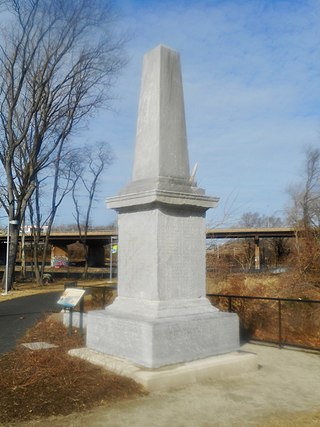
The Maryland Area Rail Commuter (MARC) is a commuter rail system in the Washington–Baltimore area. MARC is administered by the Maryland Transit Administration (MTA) and operated under contract by Alstom and Amtrak on track owned by CSX Transportation (CSXT) and Amtrak. In 2023, the system had a ridership of 3,860,600, or about 13,900 per weekday as of the third quarter of 2024, less than pre-COVID-19 pandemic weekday ridership of 40,000.

The Northeast Corridor Line is a commuter rail service operated by NJ Transit between the Trenton Transit Center and New York Penn Station on Amtrak's Northeast Corridor in the United States. The service is the successor to Pennsylvania Railroad commuter trains between Trenton and New York, and is NJ Transit's busiest commuter rail service. After arrival at New York Penn Station, some trains load passengers and return to New Jersey, while others continue east to Sunnyside Yard for storage. Most servicing is done at the Morrisville Yard, at the west end of the line.

The Reading Company was a Philadelphia-headquartered railroad that provided passenger and freight transport in eastern Pennsylvania and neighboring states from 1924 until its acquisition by Conrail in 1976.

Suburban Station is an art deco office building and underground commuter rail station in Penn Center in Philadelphia. Its official SEPTA address is 16th Street and JFK Boulevard. The station is owned and operated by SEPTA and is one of the three core Center City stations on the SEPTA Regional Rail and one of the busiest stations in the Regional Rail System.

The Philadelphia, Wilmington and Baltimore Railroad (PW&B) was an American railroad that operated independently from 1836 to 1881. Headquartered in Philadelphia, it was greatly enlarged in 1838 by the merger of four state-chartered railroads in three Mid-Atlantic states to create a single line between Philadelphia and Baltimore.
The Baltimore and Philadelphia Railroad was a railroad line built by the Baltimore and Ohio Railroad (B&O) from Philadelphia, Pennsylvania, to the Maryland-Delaware state line, where it connected with the B&O's Philadelphia Branch to reach Baltimore, Maryland. It was built in the 1880s after the B&O lost access to its previous route to Philadelphia, the Philadelphia, Wilmington and Baltimore Railroad (PW&B). The cost of building the new route, especially the Howard Street Tunnel on the connecting Baltimore Belt Line, led to the B&O's first bankruptcy. Today, the line is used by CSX Transportation for freight trains.
The National Railway or National Air Line Railroad was a planned air-line railroad between New York City and Washington, D.C. in the United States around 1870. Part of it was eventually built from New York City to Philadelphia by the Delaware and Bound Brook Railroad and the Delaware River Branch of the North Pennsylvania Railroad, leased by the Philadelphia and Reading Railway, in 1879, and becoming its New York Branch. The line was intended to provide an alternate to the various monopolies that existed along the route, specifically the United New Jersey Railroad and Canal Companies and their Camden and Amboy Railroad, and as such had a long struggle to be built.

Philadelphia was an early railroad hub, with lines from all over meeting in Philadelphia. The first railroad in Philadelphia was the Philadelphia, Germantown and Norristown Railroad, opened in 1832 north to Germantown. At the end of 1833, the state-built Philadelphia and Columbia Railroad, part of the Main Line of Public Works, opened for travel to the west, built to avoid loss of travel through Pennsylvania due to projects such as the Erie Canal. At the same time, the north-south leg of the Philadelphia City Railroad opened, running south along Broad Street from the Philadelphia and Columbia.

The Harrisburg Subdivision is a railroad line owned by CSX Transportation in Pennsylvania. The line is located in Philadelphia, and connects Greenwich Yard and the Philadelphia Subdivision with the Trenton Subdivision along a former Pennsylvania Railroad line. Much of the Harrisburg Subdivision is the High Line' or West Philadelphia Elevated along 31st Street over the 30th Street Station area.

The Trenton Subdivision is a railroad line owned by CSX Transportation in the U.S. states of Pennsylvania and New Jersey. The line runs from CP NICE in Philadelphia, Pennsylvania, northeast to Port Reading Junction in Manville, New Jersey. The line was formerly part of the Reading Company system.

The Schuylkill Branch was a rail line owned and operated by the former Pennsylvania Railroad (PRR) in Pennsylvania. The line ran from the Philadelphia to Harrisburg Main Line at 52nd Street in Philadelphia north via Norristown, Reading, and Pottsville to Delano Junction, about 2.5 mi (4.0 km) northeast of Delano. From Delano Junction, the PRR had trackage rights over the Lehigh Valley Railroad's Hazleton Branch and Tomhicken Branch to Tomhicken, where the PRR's Catawissa Branch began.
The Delaware Extension was a rail line owned and operated by the Pennsylvania Railroad in Philadelphia, Pennsylvania.

52nd Street is a closed train station that was located at the intersection of North 52nd Street & Merion Avenue in the West Philadelphia section of Philadelphia, Pennsylvania, United States. It was built by the Pennsylvania Railroad (PRR) at the junction of its Main Line and its Schuylkill Branch. Today, these lines are the SEPTA Regional Rail Paoli/Thorndale Line and Cynwyd Line, respectively.

Bowie State station is a regional rail station on the Northeast Corridor, located adjacent to the campus of Bowie State University in Bowie, Maryland. It is served by MARC Penn Line commuter rail trains. The station is located on a three-track section of the Northeast Corridor, with two side platforms next to the outer tracks.

The Bowie Railroad Buildings comprise three small frame structures at the former Bowie train station, located at the junction of what is now the Northeast Corridor and the Pope's Creek Subdivision in the town center of Bowie, Maryland. The complex includes a single-story freight depot, a two-story interlocking tower, and an open passenger shed. The station was served by passenger trains from 1872 until 1989, when it was replaced by Bowie State station nearby. The buildings were restored in 1992 as the Bowie Railroad Museum and added to the National Register of Historic Places in 1998.
The Pomeroy and Newark Railroad was a predecessor of the Pennsylvania Railroad in the U.S. states of Delaware and Pennsylvania. It connected Pomeroy, Pennsylvania to Newark, Delaware, and has mostly been abandoned.

The Newkirk Viaduct Monument is a 15-foot (4.6 m) white marble obelisk in the West Philadelphia neighborhood of Philadelphia, Pennsylvania. It was installed in 1839 to mark the completion of the Newkirk Viaduct, the first permanent railroad bridge over the Schuylkill River. It is inscribed with the names of 51 railroad builders and executives, among other information.

The Philadelphia and Baltimore Central Railroad (P&BC) was a railroad that operated in Pennsylvania and Maryland in the 19th and early 20th centuries. It operated a 110-mile (180 km) main line between West Philadelphia and Octoraro Junction, Maryland, plus several branch lines.
Lanham station was a regional rail station on the Northeast Corridor, located just outside the Capital Beltway off Route 450 in Lanham, Maryland. It was served by the predecessor of today's MARC Penn Line, until August 1982.

Woodbury is a defunct commuter railroad station in the city of Woodbury, Gloucester County, New Jersey. Located at the junction of Station Road and Cooper Street, the station served multiple lines of the Pennsylvania-Reading Seashore Lines and the Pennsylvania Railroad. Trains out of Woodbury serviced lines to Salem, Millville, Penns Grove/Carneys Point and Cape May. Woodbury station consisted of two side platforms and a 72-by-20-foot brick station depot.
















